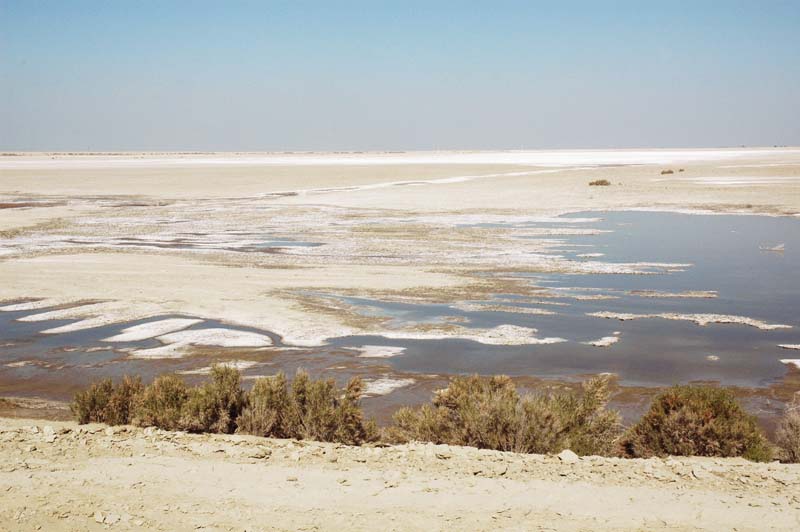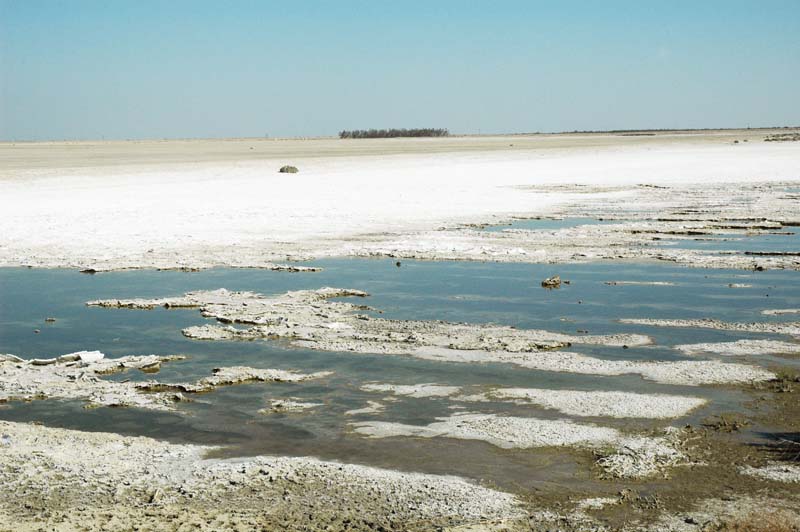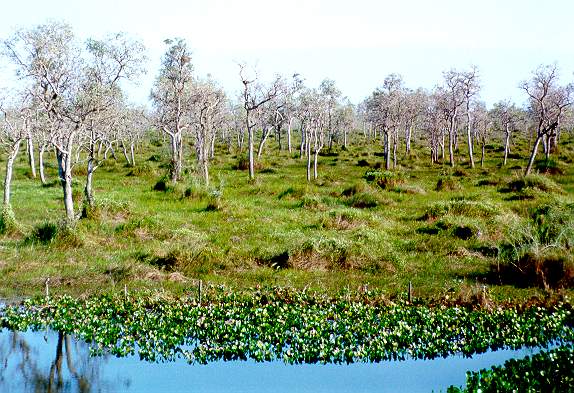|
SEQUESTERING ALL RUNOFF
1. NATURE'S BALANCE
1.1 1.2 On a global annual basis, about two thirds of the precipitation returns to the atmosphere; the remaining one third goes on to constitute runoff. 1.3 Nature would not have done it otherwise and still follow basic laws. 1.4 If all the precipitation is converted to runoff, there is no water left to sustain the vegetation. 1.5 Conversely, if all the precipitation is converted to evaporation and transpiration, there is no water left to carry the solids to the ocean. 1.6 Under this last scenario, the natural process of weathering would eventually accumulate salts on the land without limit, increasing the number and size of deserts.  Evaporation pond, Tulare Lake Basin, California.
Evaporation pond, Tulare Lake Basin, California.
1.7 Instead, Nature intended for there to be a balance: Globally, two thirds of water for the plants; the remaining one third to flush the solids to the ocean. 1.8 The ratios vary as a function of climate, geology, geomorphology, and relative continental location. 1.9 Peripheral continental regions are usually exorheic and thus, are generally able to drain their salts effectively and remain largely free of salt accumulations.  Russian river, California, near its mouth.
Russian river, California, near its mouth.
1.10 Non-peripheral continental regions are sometimes endorheic; that is, they have zero outflow. 1.11 Unable to drain their salts, these endorheic drainages are plagued with salt accumulations over time. 1.12 Once salts move in, they discourage diverse ecosystem growth, effectively contributing to the development of deserts.
2. ENTERS HUMANS 2.1 Enter humans and contemporary human society. 2.2 A sizable fraction of the available water having already been committed to the plant kingdom, we are free to tap only the remaining fraction, i.e., the runoff. 2.3 More often than not, however, we forget that the runoff has already been committed by Nature to carry the solids to the ocean, i.e., to flush the land of its salts. 2.4 This leads to the ill advised practice of sequestering all the runoff, presumably for economic use.  Lake bottom, Tulare Lake Basin, California.
Lake bottom, Tulare Lake Basin, California.
2.5 The often convincing argument is that we should not waste a drop of water, because water is precious. 2.6 Common sense, however, should point otherwise. 2.7 If we succeed in sequestering all the runoff, we would also be sequestering all the solids!  Evaporation pond, Tulare Lake Basin, California.
Evaporation pond, Tulare Lake Basin, California.
2.8 This, of course, is counterproductive because it is unsustainable. 2.9 A peripheral continental basin which fails to remain in salt balance will eventually degrade to the point where it mimics salt-infested endorheic basins, which are naturally out of salt balance.  Evaporation pond, Tulare Lake Basin, California.
Evaporation pond, Tulare Lake Basin, California.
2.10 A sensible course of action is to reserve a portion of the runoff to carry the salts to the sea. 2.11 This important decision has to be done with attention to conflicting societal interests. 2.12 A carefully calculated salt balance will determine whether a peripheral continental basin subject to anthropogenic alteration is likely to remain sustainable. 2.13 A classic example of a major watershed striving to remain in salt balance is that of the Santa Ana watershed, in San Bernardino, Riverside, and Orange Counties, California.  Ocean outfall, SARI Brine Line, Huntington Beach, California.
Ocean outfall, SARI Brine Line, Huntington Beach, California.
3. CONCLUSION 3.01 One thing is patently clear: Sequestering and consuming all runoff is unsustainable, unless we are prepared to painstakingly cart the salts away to the ocean by means other than gravity. 3.02 Yet increasing our carbon footprint in the process of effecting salt removal is not sustainable either. 3.03 Therefore, we must reserve a portion of the runoff to perform this most crucial natural service.
Narrator: Victor M. Ponce Music: Fernando Oñate Editor: Aleksandr Gostomelskiy Credits: sequestering.sdsu.edu
Copyright © 2010 Visualab Productions All rights reserved
|
 Pantanal del Mato Grosso, Brazil.
Pantanal del Mato Grosso, Brazil.
 Bombuscaro river, Zamora-Chinchipe, Ecuador.
Bombuscaro river, Zamora-Chinchipe, Ecuador.